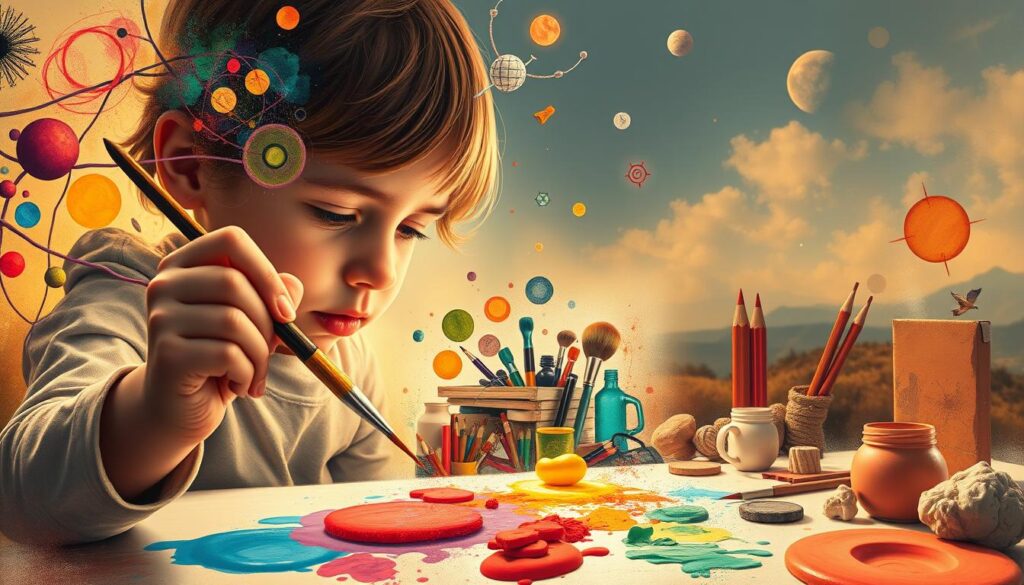There’s a moment when you stand in front of a painting or hear a song. Something inside you shifts. You stop thinking about your to-do list. Your breath slows, and your shoulders relax.
It’s not magic, but it feels like it. Art has this power. It meets you where words can’t.
Art has been healing humans for thousands of years. From ancient rituals to modern hospitals like Mayo Clinic, art helps. Programs like Arts at the Bedside reduce stress for patients and staff.
Today, science shows what our ancestors knew. Art boosts serotonin, eases anxiety, and helps us see a brighter future. Even small acts like coloring or sculpting clay can calm the mind.
Emotional wellbeing through art is real science. It’s not just a feeling.
Key Takeaways
- Artistic expression and healing improve mental health outcomes for people with conditions like anxiety and schizophrenia.
- Weekly art activities boost happiness, as seen in a study of 23,000 British adults.
- Creative hobbies like music or drawing reduce stress hormones like cortisol while strengthening emotional resilience.
- Art therapy helps children with autism or cancer communicate their feelings.
- Healthcare systems now use art to improve patient care and staff well-being.
Understanding How Art Benefits Humans
Art has a special way of improving our mental health. When we create or look at art, our brains light up. This happens in areas linked to happiness and creativity, releasing serotonin and dopamine.
These chemicals make us feel calm and happy. This shows how art can lift our mood through our biology. Even simple activities like doodling or coloring can lower stress hormones. This reduces anxiety and fatigue.
Art has a positive impact on mood by changing how we think. Studies show that looking at favorite artworks can make our brains 10% more active in pleasure centers. This is similar to seeing loved ones.
This effect happens even in short sessions. Art is a quick way to improve our mood. It also connects creativity and well-being to nonverbal expression. Art helps us express emotions that are hard to put into words, helping us stay strong during tough times.
“Art’s emotional language helps us reconnect with our humanity,” says research highlighting its role in trauma recovery.
- Reduces stress by lowering cortisol levels
- Activates reward pathways that boost self-confidence
- Promotes social bonds through shared aesthetic experiences
Whether you paint, dance, or just admire a painting, art’s effects are universal. Everyone can enjoy these benefits, no matter their skill level. The story of how art benefits humans is growing stronger every day. It shows that creativity is key to both emotional and physical health.
By making art a part of our daily lives, we care for both our minds and spirits.
The Therapeutic Power of Artistic Expression
Artistic expression is a powerful tool for healing. It has been used in mental health for decades. Studies show it can reduce stress, improve mood, and help people feel emotionally balanced.
Art Therapy Benefits for Mental Health
Art therapy is more than just making art. It helps people deal with deep emotional issues. A study found that it can lower stress hormones and boost self-esteem. It also helps people feel better after just 45 minutes of art-making.
Thanks to technology, art therapy is now available to more people. It can be done online or through virtual reality, reaching those in remote areas.
Stress Relief Through Creative Activities
Art can help reduce stress. Coloring mandalas, for example, can lower anxiety more than simple designs. Creating art can also calm the mind, reducing stress hormones.
Here’s how different activities compare:
| Activity | Stress Reduction | Why It Works |
|---|---|---|
| Mandala Coloring | High | Structured patterns ease the mind |
| VR Art | Medium-High | VR lowers stigma barriers |
| Free-Form Drawing | High | Promotes emotional release |
Emotional Processing and Resilience
Art helps people grow emotionally. It lets them turn difficult experiences into stories of strength. A study found that mandala coloring can reduce anxiety more than other designs.
Girija Kaimal, an art therapy researcher, explains:
Art helps us predict future challenges and build mental flexibility.
Creating art can be a way to express emotions. It can help people feel better and solve problems. Even simple drawing can improve self-esteem and problem-solving skills.
Art is not just for fun; it’s a way to clear your mind. Try mandala coloring, join an online class, or explore VR art. Every creative act can help improve mood and resilience.
Art’s Impact on Brain Function and Development
Art doesn’t just feel good; it changes how our brains work. Studies show that art and cognitive development are closely linked. Creative activities improve focus, memory, and problem-solving skills. Let’s see how these benefits affect minds at all ages.

Cognitive Benefits of Artistic Engagement
Creating art boosts creativity and well-being by activating key brain areas. Here’s how it happens:
- Art enhances cognitive flexibility, making it easier to switch tasks.
- Sketching or painting lowers stress hormones like cortisol, easing anxiety and improving focus.
- Learning to paint or sculpt strengthens neural pathways linked to decision-making and spatial reasoning.
Art and Neural Connectivity
Art literally rewires our brains. Here’s the science:
| Brain Region | Role During Art Engagement |
|---|---|
| Frontal Cortex | Guides planning and problem-solving |
| Amygdala | Regulates emotions tied to color and texture choices |
| Default Mode Network | Fuels imagination and daydreaming |
“Art therapy benefits include measurable changes in brain activity linked to mood regulation.”
Creative Expression Throughout Life Stages
Art’s effects change as we grow. For kids, finger painting builds fine motor skills and language development. Adults find stress relief and memory boosts through painting or music. Seniors see cognitive decline delayed by up to 30% with regular creative activities.
Every stage benefits from art’s positive impact on mood. Schools with art programs see 25% higher problem-solving scores. Hospitals use art therapy to help stroke survivors regain motor skills by stimulating neuroplasticity.
Whether drawing as a child or sculpting in retirement, art keeps brains agile and connected. The mental health benefits of art are clear—creativity is a lifelong brain booster.
Conclusion: Embracing Art for a Happier, Healthier Life
The link between art and health is clear. Art therapy lowers stress hormones and boosts mood. It makes us feel better in many ways.
Art does more than just make us feel good. It helps us be stronger, smarter, and builds community ties.
Studies show that art helps older adults in big ways. It improves their memory and social connections. Even simple activities like coloring or listening to music can help us feel balanced and less anxious.
Schools like Dr. D. Y. Patil show how art helps in learning. It boosts creativity and helps students do well in school. This fits with the WHO’s idea of health that includes mind, body, and spirit.
You don’t need to be good at art to enjoy its benefits. Just being curious and trying it out can help your health. For kids, art helps with learning and making friends. For everyone, it’s a way to deal with feelings and connect with others.
Hospitals and communities are now using art in new ways. It helps with pain and builds resilience in people with chronic illnesses. Every time we engage with art, we take a step towards feeling better.
FAQ
How does engaging with art benefit our mental health?
Engaging with art can really help our mental health. It can make us feel less anxious and depressed. This is because art makes our brains release serotonin, which makes us feel happy.
Also, making art is a special way to express feelings. It helps us say things we might not be able to say out loud.
What are the benefits of art therapy?
Art therapy is very helpful for people dealing with mental health issues. It combines making art with talking about feelings. This helps people deal with tough emotions in a safe way.
It’s great for things like PTSD, depression, and anxiety. It helps people express feelings they can’t talk about.
How does art contribute to stress relief?
Art can really help us relax. It lowers our stress hormone levels and makes us feel calm. Activities like drawing or painting can put us in a flow state.
This flow state makes us feel less worried and more at peace.
What cognitive benefits come from artistic expression?
Art makes our brains work better. It improves our problem-solving skills and attention to detail. It also makes us more creative and adaptable.
Doing art helps us think in new ways and solve problems better.
Can art improve emotional wellbeing?
Yes, art is very good for our emotional wellbeing. It helps us deal with hard feelings. By expressing ourselves through art, we can understand our emotions better.
This helps us build resilience and understand ourselves more deeply.
How does art influence cognitive development across different life stages?
Art is important for learning at every age. For kids, it helps with fine motor skills and understanding pictures. For teens, it helps them figure out who they are.
For adults, it keeps their minds sharp. For older adults, it slows down memory loss and helps them feel connected.
Why is creativity important for overall well-being?
Creativity is key for feeling good. It lets us express ourselves and think in new ways. It also reduces stress and makes us feel part of a community.
Art helps us connect with ourselves and others. It makes us happier and more fulfilled.



